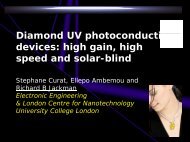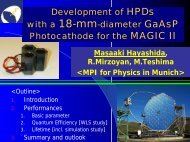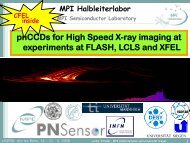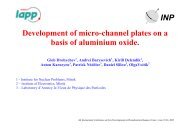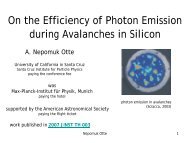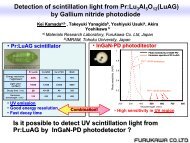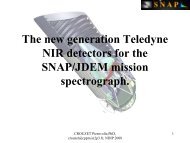You also want an ePaper? Increase the reach of your titles
YUMPU automatically turns print PDFs into web optimized ePapers that Google loves.
Silic<strong>on</strong> Photomultipliers<br />
D. Renker, PSI - Beaune 2005<br />
Dieter Renker
Name: <strong>SiPM</strong>?<br />
<strong>SiPM</strong> (Silic<strong>on</strong> PhotoMultiplier) inherently wr<strong>on</strong>g, it is a photoelectr<strong>on</strong> multiplier<br />
MPGM APD (Multipixel Geiger-mode Avalanche PhotoDiode)<br />
AMPD (Avalanche Micro-pixel PhotoDiode)<br />
SSPM (Solid State PhotoMultiplier) – already in use<br />
G-APD (Geiger-mode Avalanche PhotoDiode)<br />
GMPD (Geiger-Mode PhotoDiode)<br />
DPPD (Digital Pixel PhotoDiode)<br />
MCPC (MicroCell Phot<strong>on</strong> Counter)<br />
MAD (Multicell Avalanche Diode)<br />
<br />
<br />
And a definiti<strong>on</strong>: a <strong>SiPM</strong> is made of many small APD‘s which are c<strong>on</strong>nected in<br />
parallel. I call the whole device a pixel and the small APD‘s a cell.<br />
Beaune 2005 D. Renker, PSI
Outline<br />
From PM to <strong>SiPM</strong> in High Energy Physics<br />
History of Solid State Single Phot<strong>on</strong> Detectors<br />
Properties and Problems<br />
Applicati<strong>on</strong>s and Choice of Paramaters<br />
C<strong>on</strong>clusi<strong>on</strong><br />
Beaune 2005 D. Renker, PSI
From PM to <strong>SiPM</strong><br />
PM‘s have been developed during almost 100 years. The first photoelectric tube was<br />
produced by Elster and Geiter 1913. RCA made PM‘s a commercial product in 1936.<br />
Single phot<strong>on</strong>s can be detected with PM‘s.<br />
The high price, the bulky shape and the sensitivity to magnetic fields of PM‘s forced<br />
the search for alternatives.<br />
PIN photodiodes are very successful devices and are used in most big experiments<br />
in high energy physics (CLEO, L3, BELLE, BABAR, GLAST) but due to the noise of<br />
the neccesary amplifier the minimal detectable light pulses need to have several 100<br />
phot<strong>on</strong>s.<br />
Avalanche photodiodes have internal gain which improves the signal to noise ratio<br />
but still some 20 phot<strong>on</strong>s are needed for a detectable signal. The excess noise, the<br />
fluctuati<strong>on</strong>s of the avalanche multiplicati<strong>on</strong> limits the useful range of gain. CMS is the<br />
first big experiment that uses APD’s.<br />
<strong>SiPM</strong>‘s can detect single phot<strong>on</strong>s. They have been developed and described since<br />
the beginning of this millennium (patent of Z. Sadygov 1996). 3 years ago B.<br />
Dolgoshein presented their properties and possible applicati<strong>on</strong>s here in Beaune.<br />
Beaune 2005 D. Renker, PSI
From PM to <strong>SiPM</strong><br />
Single phot<strong>on</strong>s clearly can be detected<br />
with <strong>SiPM</strong>‘s. The pulse height spectrum<br />
shows a resoluti<strong>on</strong> which is even better<br />
than what can be achieved with a hybrid<br />
photomultiplier.<br />
Picture taken from B. Dolgoshein‘s presentati<strong>on</strong> in Beaune 2002<br />
(NIM A 504 (2003) 48)<br />
Beaune 2005 D. Renker, PSI
History of Solid State Single Phot<strong>on</strong> Detectors<br />
Pi<strong>on</strong>eering work was d<strong>on</strong>e in the nineteen sixties in the RCA company (R.J.<br />
McIntyre) and in the Shockley research laboratory (R.H. Haitz).<br />
The famous paper „Multiplicati<strong>on</strong> Noise in Uniform Avalanche Diodes“ by<br />
McIntyre appeared 1966 (IEEE Trans. Electr<strong>on</strong> Devices 13 (1966))<br />
APD‘s in linear- and in Geiger-mode were in the sixties and early seventies a<br />
very active field of experimental and theoretical research.<br />
A model of the behaviour of APD‘s operated in Geiger-mode was developed and<br />
experimentally verified with test structures.<br />
The performance of the first devices was not very good but single phot<strong>on</strong>s have<br />
been seen and with improving technology the development was leading to the<br />
Single Phot<strong>on</strong> Avalanche Diode (SPAD) and to the SLIK structure produced by<br />
Perkin-Elmer (a device with 1 mm diameter was in seventies a commercial<br />
product of RCA).<br />
Beaune 2005 D. Renker, PSI
History of Solid State Single Phot<strong>on</strong> Detectors<br />
The first 2 silic<strong>on</strong> single phot<strong>on</strong> detectors fabricated by Haitz and by<br />
McIntyre. Both had to be operated in Geiger-mode, with a bias voltage<br />
several volts higher than the breakdown voltage.<br />
hν<br />
planar diode (Haitz) reach-through diode (McIntyre)<br />
Beaune 2005 D. Renker, PSI
History of Solid State Single Phot<strong>on</strong> Detectors<br />
A somewhat different design was<br />
patented 1972 in Japan (K. Yamamoto,<br />
Hamamatsu Phot<strong>on</strong>ics).<br />
Beaune 2005 D. Renker, PSI
History of Solid State Single Phot<strong>on</strong> Detectors<br />
With the early devices the quenching of the breakdown was d<strong>on</strong>e passively. When<br />
the current fluctuati<strong>on</strong>s happens to go to zero the breakdown stops and needs a new<br />
triggering event to start again.<br />
The devices were slow and the maximal count rate was smaller than 100 kHz. This is<br />
still true for state of the art devices nowadays.<br />
Only the development of active quenching circuits allows high count rates of > 1 MHz<br />
and provides a short deadtime (S. Cova, M. Ghi<strong>on</strong>i, A. Lotito, F. Zappa, Politecnico di<br />
Milano).<br />
All these SPAD‘s and the SLIK devices are small with a diameter of<br />
less than 200 µm.<br />
Finocchiaro<br />
Beaune 2005 D. Renker, PSI
History of Solid State Single Phot<strong>on</strong> Detectors<br />
Radiati<strong>on</strong> M<strong>on</strong>itor Devices Inc. (RMD)<br />
developed an array of APD‘s with single<br />
phot<strong>on</strong> detecti<strong>on</strong> capability for DIRC<br />
applicati<strong>on</strong>s (Detecti<strong>on</strong> of Internally<br />
Reflected Cherenkov light).<br />
It c<strong>on</strong>sists of 6 x 14 individual APD‘s<br />
with a size of 150 x 150 µm 2 , is<br />
operated in Geiger-mode and has an<br />
active quenching circuit for each APD.<br />
http://www.rmdinc.com/papers/HighGainAvalanchePhotodiodeArraysforDIRCApplicati<strong>on</strong>s.htm<br />
Beaune 2005 D. Renker, PSI
History of Solid State Single Phot<strong>on</strong> Detectors<br />
In the Rockwell Internati<strong>on</strong>al Science<br />
Center Stapelbroek et al. developed<br />
1987 the Solid State PhotoMultiplier<br />
(SSPM). This is an APD with very high<br />
d<strong>on</strong>or c<strong>on</strong>centrati<strong>on</strong> which creates an<br />
impurity band 50 meV below the<br />
c<strong>on</strong>ducting band.<br />
Later this device was modified to be<br />
less sensitive to infrared light and is<br />
now called Visible Light Phot<strong>on</strong><br />
Counter (VLPC).<br />
The small band gap forces an<br />
operati<strong>on</strong> at very low temperatures of<br />
few degree Kelvin.<br />
Atac<br />
Beaune 2005 D. Renker, PSI<br />
A Bross et al., NIM A 477 (2002) 172
History of Solid State Single Phot<strong>on</strong> Detectors<br />
Around 1990 the MRS (Metal- Resistor-<br />
Semic<strong>on</strong>ductor) APD‘s were invented in<br />
Russia.<br />
A very thin metal layer (Ti,~ 0.01 µm) and a<br />
layer of SiC or Si X O Y with a resistivity of 30<br />
to 80 MΩcm limits the Geiger breakdown<br />
by a local reducti<strong>on</strong> of the electric field.<br />
The technolgy is difficult because all<br />
parameters need to be c<strong>on</strong>trolled very<br />
precisely.<br />
Two examples out of a great number of<br />
different designs are shown. Both have<br />
been presented here in Beaune (99, 02)<br />
Beaune 2005 D. Renker, PSI<br />
Antich et al., NIM A 389 (1997) 491<br />
Saveliev and Golovin, Beaune 1999 (NIM A 442 (2000) 223)
History of Solid State Single Phot<strong>on</strong> Detectors<br />
The next step was logical:<br />
Subdivide the MRS structure into<br />
many cells and c<strong>on</strong>nect them all in<br />
parallel via an individual limiting<br />
resistor. The <strong>SiPM</strong> is born.<br />
Key pers<strong>on</strong>alities in this development<br />
are V. Golovin and Z. Sadygov.<br />
The technology is simple. It is a<br />
standard MOS (Metal-Oxide-Silic<strong>on</strong>)<br />
process and promises to be cheap.<br />
An educated guess is a price of<br />
some 10 € per cm 2 .<br />
Savaliev, Musienko, Popova, Sadygov, Dolgoshein, Swain, Renker<br />
Beaune 2005 D. Renker, PSI<br />
Picture taken from B. Dolgoshein‘s presentati<strong>on</strong> in Beaune<br />
2002 (NIM A 504 (2003) 48)<br />
From Sadygov‘s patent (1998)
History of Solid State Single Phot<strong>on</strong> Detectors<br />
Beaune 2005 D. Renker, PSI
Properties and Problems<br />
<strong>SiPM</strong> produce a standard<br />
signal when any of the cells<br />
goes to breakdown. The<br />
amplitude A i is proporti<strong>on</strong>al to<br />
the capacitance of the cell<br />
times the overvoltage.<br />
A i ~ C •(V –V b )<br />
When many cells fire at the<br />
same time the output is the<br />
sum of the standard pulses<br />
A = ∑ A i<br />
Beaune 2005 D. Renker, PSI<br />
Type: Hamamatsu 1-53-1A-1, cell size 70 x 70 µm
Properties and Problems: High Gain<br />
The gain is in the range of 10 5 to 10 7 . Single phot<strong>on</strong>s produce a signal of several<br />
millivolts <strong>on</strong> a 50 Ohm load. No or at most a simple amplifier is needed.<br />
Pickup noise is no more a c<strong>on</strong>cern (no shielding).<br />
There is no nuclear counter effect – even a heavily i<strong>on</strong>izing particle produces a signal<br />
which is not bigger than that of a phot<strong>on</strong>.<br />
Since there are no avalanche fluctuati<strong>on</strong>s (as we have in APD‘s) the excess noise<br />
factor is very small, could eventually be <strong>on</strong>e.<br />
Grooms theorem (the resoluti<strong>on</strong> of an assembly of a scintillator and a semic<strong>on</strong>ductor<br />
photodetector is independent of the area of the detector) is no more valid.<br />
Beaune 2005 D. Renker, PSI
Properties and Problems: Saturati<strong>on</strong><br />
The output signal is proporti<strong>on</strong>al to the<br />
number of fired cells as l<strong>on</strong>g as the<br />
number of phot<strong>on</strong>s in a pulse (N phot<strong>on</strong> )<br />
times the photodetecti<strong>on</strong> efficiency PDE<br />
is significant smaller than the number of<br />
cells N total .<br />
A ≈<br />
N<br />
firedcells<br />
=<br />
N<br />
total<br />
⋅(<br />
1−<br />
e<br />
N<br />
−<br />
phot<strong>on</strong><br />
2 or more phot<strong>on</strong>s in 1 cell look exactly<br />
like 1 single phot<strong>on</strong><br />
Beaune 2005 D. Renker, PSI<br />
N<br />
⋅PDE<br />
total<br />
)<br />
from B. Dolgoshein, The <strong>SiPM</strong> in Particle Physics
Properties and Problems: Dark Counts<br />
A breakdown can be triggered by an incoming<br />
phot<strong>on</strong> or by any generati<strong>on</strong> of free carriers. The<br />
latter produces dark counts with a rate of 100 kHz<br />
to several MHz per mm 2 at 25°C and with a<br />
treshold at half of the <strong>on</strong>e phot<strong>on</strong> amplitude.<br />
Thermally generated free carriers can be reduced<br />
by cooling (factor 2 reducti<strong>on</strong> of the dark counts<br />
every 8°C) and by a smaller electric field (lower<br />
gain).<br />
Field-assisted generati<strong>on</strong> (tunneling) can <strong>on</strong>ly be<br />
reduced by a smaller electric field (lower gain).<br />
Reduce the number of generati<strong>on</strong>-recombinati<strong>on</strong><br />
centers in the <strong>SiPM</strong> producti<strong>on</strong> process.<br />
Open questi<strong>on</strong>: Radiati<strong>on</strong> hardness<br />
Beaune 2005 D. Renker, PSI
Properties and Problems: : Optical Crosstalk<br />
Hot-Carrier Luminescence:<br />
10 5 carriers in an avalanche breakdown<br />
emit in average 3 phot<strong>on</strong>s with an energy<br />
higher than 1.14 eV. A. Lacaita et al, IEEE TED (1993)<br />
When these phot<strong>on</strong>s travel to a<br />
neighbouring cell they can trigger a<br />
breakdown there.<br />
Optical crosstalk acts like shower<br />
fluctuati<strong>on</strong>s in an APD. It is a stochastic<br />
process. We get the excess noise factor<br />
back.<br />
Optical isolati<strong>on</strong> between pixels<br />
Operate at relative low gain<br />
Beaune 2005 D. Renker, PSI<br />
Type: Hamamatsu 1-53-1A-1, cell size 70 x 70 µm
Properties and Problems: : Afterpulsing<br />
Carrier trapping and delayed release causes afterpulses during a period of<br />
several microsec<strong>on</strong>ds.<br />
Afterpulses with short delay<br />
c<strong>on</strong>tribute little because the cells<br />
are not fully recharged but have an<br />
effect <strong>on</strong> the recovery time.<br />
Low temperatures el<strong>on</strong>gate the<br />
release (factor of 3 for 25°C).<br />
Beaune 2005 D. Renker, PSI<br />
From S. Cova et al., Evoluti<strong>on</strong> and Prospect of Single-<br />
Phot<strong>on</strong> Avalanche Diodes and Quenching Circuits<br />
(NIST Workshop <strong>on</strong> Single Phot<strong>on</strong> Detectors 2003)
Properties and Problems: : Phot<strong>on</strong> Detecti<strong>on</strong> Efficiency<br />
The phot<strong>on</strong> detecti<strong>on</strong> efficiency (PDE) is the product of quantum efficiency of the<br />
active area (QE), a geometric factor (ε, ratio of sensitiv to total area) and the<br />
probability that an incoming phot<strong>on</strong> triggers a breakdown (P trigger )<br />
PDE = QE · ε ·P trigger<br />
QE is maximal 80 to 90% depending <strong>on</strong> the wavelength.<br />
The QE peaks in a relative narrow range of wavelengths because the sensitive<br />
layer of silic<strong>on</strong> is very thin (in the case shown the p + layer is 0.8 µm thick)<br />
QE [%]<br />
100<br />
90<br />
80<br />
70<br />
60<br />
50<br />
40<br />
30<br />
20<br />
10<br />
0<br />
Hamamatsu 0-50-2 (400 cells)<br />
350 400 450 500 550 600 650 700 750 800<br />
Wavelength [nm]<br />
Beaune 2005 D. Renker, PSI<br />
abs. length of light in Si<br />
[micr<strong>on</strong>]<br />
100<br />
10<br />
1<br />
0.1<br />
Dash and Newman<br />
0.01<br />
300 400 500 600 700 800 900<br />
wavelegth [nm]
Properties and Problems: : Phot<strong>on</strong> Detecti<strong>on</strong> Efficiency<br />
The geometric factor ε needs to be optimized<br />
depending <strong>on</strong> the applicati<strong>on</strong>.<br />
Since some space is needed between the cells<br />
for the individual resistors and is needed to<br />
reduce the optical crosstalk the best filling can<br />
be achieved with a small number of big cells.<br />
In a camera for air Cherenkov telescopes the<br />
best possible PDE is wanted. Since the number<br />
of phot<strong>on</strong>s is small big cells are suitable and a<br />
geometric factor of 50% and more is possible.<br />
LSO crystals for PET produce many phot<strong>on</strong>s<br />
and 1000 or more can be collected at the<br />
endface of the crystals. In order to avoid a<br />
saturati<strong>on</strong> effect the number of cells needs to be<br />
big and the cells small. The geometric factor will<br />
be in the range of 20 to 30%.<br />
Beaune 2005 D. Renker, PSI<br />
Microscopic view of a <strong>SiPM</strong><br />
produced by Z. Sadygov
Properties and Problems: : Phot<strong>on</strong> Detecti<strong>on</strong> Efficiency<br />
The triggering probability depends <strong>on</strong> the<br />
positi<strong>on</strong> where the primary electr<strong>on</strong>-hole<br />
pair is generated.<br />
And it depends <strong>on</strong> the overvoltage. High<br />
gain operati<strong>on</strong> is favoured.<br />
Electr<strong>on</strong>s have in silic<strong>on</strong> a better chance<br />
to trigger a breakdown than holes.<br />
Therefore a c<strong>on</strong>versi<strong>on</strong> in the p+ layer<br />
has the highest probability.<br />
A material other than silic<strong>on</strong> in which the<br />
holes have a higher mobility and higher<br />
i<strong>on</strong>izati<strong>on</strong> coefficient like GaAs could<br />
have a very high trigger probabilty.<br />
Beaune 2005 D. Renker, PSI<br />
W.G. Oldham et al., IEEE TED 19, No 9 (1972)
Properties and Problems: : Recovery Time<br />
The time needed to recharge a cell after a<br />
breakdown has been quenched depends<br />
mostly <strong>on</strong> the cell size (capacity) and the<br />
individual resistor (RC).<br />
Afterpulses can prol<strong>on</strong>g the recovery time<br />
because the recharging starts anew. Can<br />
be reduced by low gain operati<strong>on</strong>.<br />
Beaune 2005 D. Renker, PSI<br />
Recovery Time [microsec]<br />
20<br />
18<br />
16<br />
14<br />
12<br />
10<br />
8<br />
6<br />
4<br />
2<br />
0<br />
49.5 50 50.5 51 51.5<br />
Bias Voltage [V]<br />
Some <strong>SiPM</strong> need hundreds of microsec<strong>on</strong>ds after a breakdown until the<br />
amplitude of a sec<strong>on</strong>d signal reaches 95% of the first signal. Smallest values<br />
for <strong>SiPM</strong>‘s with small cells and small resistors.<br />
Since polysilic<strong>on</strong> resistors are used up to now which change their value with<br />
the temperature. Therefore there is a str<strong>on</strong>g dependence of the recovery time<br />
<strong>on</strong> the temperature. Go to a metal alloy with high resistivity like FeCr.<br />
Britvitch
Properties and Problems: : Timing<br />
The active layers of silic<strong>on</strong> are very<br />
thin (2 to 4 µm), the avalanche<br />
breakdown process is fast and the<br />
signal amplitude is big. We can<br />
therefore expect very good timing<br />
properties even for single phot<strong>on</strong>s.<br />
Fluctuati<strong>on</strong>s in the avalanche are<br />
mainly due to a lateral spreading by<br />
diffusi<strong>on</strong> and by the phot<strong>on</strong>s emitted in<br />
the avalanche.<br />
A. Lacaita et al., Apl. Phys. Letters 62 (1992)<br />
A. Lacaita et al., Apl. Phys. Letters 57 (1990)<br />
High overvoltage (high gain) improves<br />
the time resoluti<strong>on</strong>.<br />
Merck<br />
Beaune 2005 D. Renker, PSI<br />
C<strong>on</strong>tributi<strong>on</strong> from the laser and the electr<strong>on</strong>ics is<br />
40 ps each. time resoluti<strong>on</strong> 100 ps FWHM<br />
taken from B. Dolgoshein‘s presentati<strong>on</strong><br />
in Beaune 2002 (NIM A 504 (2003) 48)
Properties and Problems: : Timing<br />
Carriers created in field free regi<strong>on</strong>s<br />
have to travel by diffusi<strong>on</strong>. It can take<br />
several tens of nanosec<strong>on</strong>ds until they<br />
reach a regi<strong>on</strong> with field and trigger a<br />
breakdown.<br />
At low gain the lateral spreading of the<br />
depleted volume can be uncomplete<br />
and can enhance the diffusi<strong>on</strong> tail.<br />
Pictures from S. Cova et al., Evoluti<strong>on</strong> and Prospect of<br />
Single-Phot<strong>on</strong> Avalanche Diodes and Quenching Circuits<br />
(NIST Workshop <strong>on</strong> Single Phot<strong>on</strong> Detectors 2003)<br />
Beaune 2005 D. Renker, PSI
Properties and Problems<br />
There are more features which are not menti<strong>on</strong>ed yet:<br />
<strong>SiPM</strong>‘s work at low bias voltage (~50 V),<br />
have low power c<strong>on</strong>sumpti<strong>on</strong> (< 50 µW/mm 2 ),<br />
are insensitive to magnetic fields up to 15 T,<br />
are compact and rugged,<br />
have a very small nuclear counter effect (sensitivity to charged particles),<br />
have relative small temperature dependence,<br />
and tolerate accidental illuminati<strong>on</strong><br />
Beaune 2005 D. Renker, PSI
Choice of Paramaters<br />
Many different designs are possible:<br />
Semic<strong>on</strong>ductor material – PDE, wavelength<br />
p-silic<strong>on</strong> <strong>on</strong> a n-substrate – highest detecti<strong>on</strong> efficiency for blue light<br />
n-silic<strong>on</strong> <strong>on</strong> a p-substrate – highest detecti<strong>on</strong> efficiency for green light<br />
Thickness of the layers – range of wavelength, crosstalk<br />
Doping c<strong>on</strong>centrati<strong>on</strong>s – operating voltage and its range<br />
Impurities and crystal defects – dark counts, afterpulses<br />
Area of the cells – gain, geometric factor, dynamic range, recovery time<br />
Value of the resistors – recovery time, count rate/cell<br />
Type of resistors – temperature dependence<br />
Optical cell isolati<strong>on</strong> (groove) – crosstalk<br />
Beaune 2005 D. Renker, PSI
Choice of Paramaters<br />
In my opini<strong>on</strong> the future development should go in few seperate directi<strong>on</strong>s:<br />
Many applicati<strong>on</strong>s need the highest possible phot<strong>on</strong> detecti<strong>on</strong> efficiency but d<strong>on</strong>‘t<br />
need high dynamic range (RICH, DIRC, IACT, EUSO, phot<strong>on</strong> correlati<strong>on</strong> studies,<br />
fluorescence spectroscopy, single electr<strong>on</strong> LIDAR, neutrino detectors).<br />
best is a <strong>SiPM</strong> with p- <strong>on</strong> n-silic<strong>on</strong> structure, large cells (50 to 100 µm 2 ),<br />
small value of the resistor and optical isolati<strong>on</strong> between the cells<br />
Other applicati<strong>on</strong>s need large dynamic range (HEP calorimeters, PET, SPECT,<br />
scintillator readout, Smart PMT, radiati<strong>on</strong> m<strong>on</strong>itors).<br />
here the best is p- <strong>on</strong> n-silic<strong>on</strong> structure again, small cells (5 to 30 µm 2 ),<br />
thicker p- layer, no optical isolati<strong>on</strong> needed<br />
Some applicati<strong>on</strong>s like a tile calorimeter are better off with a n- <strong>on</strong> p-silic<strong>on</strong><br />
structure.<br />
Akindinov, Borrel<br />
Beaune 2005 D. Renker, PSI
C<strong>on</strong>clusi<strong>on</strong>s<br />
Multi-cell APD‘s operated in Geiger-mode are now an alternative to PM‘s.<br />
They are the better choice for the detecti<strong>on</strong> of light with very low intensity<br />
when there is a magnetic field and when space and power c<strong>on</strong>sumpti<strong>on</strong> are<br />
limited.<br />
Most of the devices are still small (1x1 mm 2 ) but areas of 3x3 mm 2 are<br />
available and a <strong>SiPM</strong> with 10x10 mm 2 is planed. Also planed is a m<strong>on</strong>olithic<br />
array of 4 diodes with 1.8x1.8 mm 2 each.<br />
The development started some 10 years ago but still there is a broad room<br />
for improvements. Many parameters can be adjusted to optimise the devices.<br />
We need a good name and I would like to have a democratic vote. This<br />
c<strong>on</strong>ference is a good place for it.<br />
Beaune 2005 D. Renker, PSI
Name: <strong>SiPM</strong>?<br />
<strong>SiPM</strong> (Silic<strong>on</strong> PhotoMultiplier) inherently wr<strong>on</strong>g, it is a photoelectr<strong>on</strong> multiplier<br />
MPGM APD (Multipixel Geiger-mode Avalanche PhotoDiode)<br />
AMPD (Avalanche Micro-pixel PhotoDiode)<br />
SSPM (Solid State PhotoMultiplier) – already in use<br />
G-APD (Geiger-mode Avalanche PhotoDiode)<br />
GMPD (Geiger-Mode PhotoDiode)<br />
DPPD (Digital Pixel PhotoDiode)<br />
MCPC (MicroCell Phot<strong>on</strong> Counter)<br />
MAD (Multicell Avalanche Diode)<br />
<br />
<br />
Beaune 2005 D. Renker, PSI



